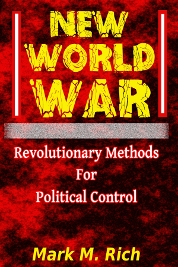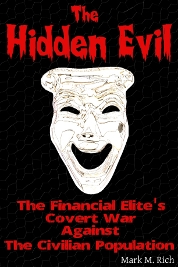Main Menu
Updates
-
Update: December 22, 2025
No Book Reviews....more - Important Updates
- Previous Updates
- Attack Log
Donations
- I accept cryptocurrency & PayPal
Available Books
New World War: Revolutionary Methods for Political Control
Dedication & Thanks
Volume I: Current Political Situation
- Overview
- Introduction
- Revolution in Warfare
- The Other World
- Dictatorship Creation
- The Groups Facilitating the Revolution
- Their Goal is Neo-Feudalism
- Problem-Reaction-Solution
- Volume I Commentary
Volume II: The New War
- The New War
- The New Enemy
- Initiatives to Remove Civil Liberties
- The Investigation
- Surveillance Technology and Methods
- Mind-Reading
- Volume II Commentary
Volume III: Weapons of The New War
- Introduction to Nonlethal Weapons
- Psychological Operations
- Introduction to Directed-Energy Weapons
- High-Powered Microwaves
- High-Powered Lasers
- Sonic Weapons
- Computer Network Operations
- Microwave Hearing
- Silent Subliminals
- Use of Citizen Informants
- Chemical and Biological
- Weather Warfare
- Miscellaneous Weapons and Tactics
- Volume III Commentary
Volume IV: The Coverup
- Volume IV Introduction
- Schizophrenia Spectrum Disorders
- Control of the Medical Industry
- Another Look at Schizophrenia
- Political Considerations
- Punitive Psychiatry in Communist Russia
- Coverup Initiatives
- Volume IV Commentary
- Conclusion
Appendix
- A Brief History of PsyOp
- Small-Scale Wars
- Nongovernmental Organizations
- Human-Computer Intelligence Network
- Electronic Tyranny
- Other Devices Connected to the GIG
- My Experience
- Sources
Other Sites
Much of the social science research which led to the creation of modern PsyOp was carried out from the 1930s to the 1950s at academic institutions such as Columbia, Princeton, MIT, Harvard, Yale, and others. It was sponsored by private foundations such as Menninger, Rockefeller, Russell Sage, and Ford, as well as the Carnegie Corporation, which worked with think tanks such as the RAND Corporation and Council on Foreign Relations. The US military and CIA went into partnership with these groups to conduct these studies.
It was not until WWI that the US institutionalized PsyOp in its current form. President Wilson was a major contributor to its early development. In 1917, he appointed George Creel to lead an elite Committee of Public Information composed of US Secretaries of War, Navy, and State to conduct research pertaining to PsyOp.
After WWI US PsyOp projects continued in academia, particularly in the expanding field of communications. An early contributor to this research was a political scientist and communications expert named Harold Lasswell.
Lasswell authored the 1926 publication, Propaganda Technique in the World War, where he described propaganda programs used by the enemy by providing case studies in persuasive communication, audience psychology, and the manipulation of symbols. He believed that communication of this kind could be used by a specialized class of wealthy elites to promote their version of social order.
In 1941 Lasswell wrote an article in the American Journal of Sociology entitled, The Garrison State, where he explained how a type of scientific dictatorship could be created which would be ruled by political-military elite, who would use symbols to control public opinion.
Another early contributor, Walter Lippmann, based his writings, Public Opinion of 1922 and The Phantom Public of 1925, on his experience in a US propaganda unit with American Expeditionary Forces during WWI. Lippmann also believed that communication could be used by a ruling class to impose its will on others. He wrote multiple books and articles describing how a specialized class of experts, specialists, and bureaucrats would use manipulation to rule society. He was a founding member of the Council on Foreign Relations.
More research on PsyOp was spurred by WWII, during which time a network of social scientists and communications experts sprung up that played a central role in PsyOp development into the 1950s. During the late 1930s the Rockefeller Foundation contributed much to this research. The foundation’s administrators thought that mass media could be used as a powerful manipulative force in modern society. Over the course of about two years, the foundation sponsored Harold Lasswell to conduct research on how to engineer mass consent using “manipulation and deceit.”
Shortly after WWII and into the 1950s PsyOp research was funded by the Office of Naval Research (ONR), Air Force, Army, and CIA, which contracted with major institutions such as the Bureau of Applied Social Research (BASR) at Columbia, the Institute for International Social Research (IISS) at Princeton, the Center for International Studies (CENIS) at MIT, the Institute for Social Research at the University of Michigan, the National Opinion Research Center, and the RAND Corporation. These studies pertained to techniques of persuasion, opinion measurement, interrogation, political and military mobilization, ideology dissemination, etc.
This small informal network that was created during WWII consisted of government agencies partnering with private foundations, think tanks, and academic institutions. It favored certain federal contractors to conduct social science research. One example of this is the Interservice Committee on Human Resources, which was created in 1947 by the DOD to coordinate all military spending on communication studies, social psychology, sociology, and the social sciences.
The DOD and a group of influential academic individuals used the committee as a confidential focal point for government and academic networking. Its 1949 chairman was Donald Marquis of the University of Michigan, also the president of the American Psychological Association. One committee member was William C. Menninger of the Menninger Foundation, a major defense contractor.
Others were Carroll Shartle of Ohio State University and future chief of the Psychology and Social Science Division of the Office of the Secretary of Defense, as well as Samuel Stouffer of Harvard. Contributors to the committee included Henry Brosin of the University of Chicago, Frederick Stephan of Princeton, Walter Hunter of Brown, and the future chief of the Bureau of Social Science Research (BSSR) Raymond Bowers.
Although the committee didn’t allocate funds, it was responsible for the overall social science portion of the military budget. It recommended and approved major research projects. The committee had four divisions. Of particular interest is the Panel on Human Relations and Morale which oversaw most of the psychological warfare research for the military.
The panel was composed of military and academic specialists that conducted studies on PsyOp. It was chaired by Charles Dollard, president of Carnegie Corporation. One of its members was Hans Speier, trustee of the RAND Corporation.
Advisors to the panel included members of the Bureau of Applied Social Research (BASR) at Columbia University, such as Harry Alpter (also of Yale) and Kingsley Davis (director of BASR), as well as John Gardener of the Carnegie Corporation, Harold Lasswell of Yale, and Elmo Wilson of a major US government contractor called International Research Associates. The committee’s budget, papers, and meeting material were classified.
During the 1940s/WWII period there were several other main centers of PsyOp and related activities in the US. They included the Research Branch of the Office of War Information (OWI), the Office of Strategic Services (OSS), and the Psychological Warfare Division of the US Army (PWD). Through these and other organizations, prominent social scientists participated in research projects during the war.
Some notables include Leonard Doob of Yale, Wilbur Schramm of the University of Illinois, Alexander Leighton of Cornell, Hans Speier and Nathan Leites (both of the RAND Corporation), Edward Barrett of Columbia, Clyde Kluckhohn of Harvard, and Devereux Josephs of Harvard and Carnegie Corporation. Some of these individuals served in two or more groups at the same time.
Wilbur Schramm, for instance, was a social scientist at the University of Illinois and Stanford. He was a central figure among social scientists in the US regarding communication research between 1948 and 1970. His writings on propaganda, such as The Process and Effects of Mass Communication, have been used as training manuals for US government propaganda programs. During WWII Schramm worked at the OWI. Some of his important work done in the 1950s concerning PsyOp was conducted in connection with the CIA and military, and therefore, remains classified.
Devereux Josephs of Harvard University was president of Carnegie Corporation from 1945 to 1948, just prior to it running the Panel on Human Relations and Morale under the Interservice Committee on Human Resources, created by the DOD in 1947. He was also a member of the Council on Foreign Relations during this time.
The Office of War Information (OWI) was a main US center for PsyOp and related studies during WWII that functioned from 1942 to 1945. It released domestic news stories and radio broadcasts to promote patriotism. Its members included editors of Time, Look, Fortune, Holiday, Coronet, Parade, Saturday Review, and the Denver Post, as well as publishing houses such as Viking Press and Harper Brothers, in addition to large advertising firms. The OWI was dismantled by congress after it was discovered that the propaganda it disseminated contributed to Roosevelt’s 1944 reelection.
The Psychological Warfare Division of the US Army (PWD) was another major center for PsyOp studies during WWII. In 1951 it published, Bullets or Words, describing how PsyOp was successfully used as a weapon in WWII and the Korean Conflict. They stated that the “new psychological weapons” that had been developed based on “sound scientific principles” should be used in every future military action.
From the 1940s into the 1960s the RAND Corporation conducted a variety of social science research, which included its participation in the Panel on Human Relations and Morale. Beginning in 1951 Chitra M. Smith at the Bureau of Social Science Research (BSSR) prepared for RAND a series of papers entitled, International Propaganda and Psychological Warfare. RAND was commissioned by DARPA in the early 1960s to develop methods to break the underground resistance in Vietnam.
The Bureau of Applied Social Research (BASR) at Columbia University helped to research government-sponsored psychological warfare projects shortly after WWII and into the 1950s. This included providing advisors to the Panel on Human Relations and Morale such as Harry Alpter (also of Yale) and its director, Kingsley Davis.
During the 1950s the Rockefeller and Russell Sage foundations contributed heavily to social science research, some of which occurred at the Institute for International Social Research (IISR) run by Hadley Cantril at Princeton University. The Rockefeller Foundation was used during this time as a front to conceal at least $1 million in CIA research conducted at the IISR. Nelson Rockefeller was an advocate of PsyOp and served as an advisor to Eisenhower on the subject from 1954 to 1955.
Cantril was the primary author of the 1940 book, The Invasion from Mars, which was based on a 1938 radio broadcast which convinced many people that an alien invasion had taken place. This was reported in the New York Times on October 30, 1938 where it observed that thousands of people across the US were deceived into thinking that aliens were taking over the planet. The broadcast caused a nation-wide panic. It has been suggested that it was a psychological test done on the public. According to the 1999 documentary, Masters of the Universe: The Secret Birth of the Federal Reserve, the Rockefeller Foundation funded the broadcast in order to study the resulting panic.
Leonard Cottrell, an enthusiastic promoter of PsyOp, is another example of an individual serving in multiple organizations spanning the private and federal realm. From 1951 to 1967 he was the chief social psychologist at the Russell Sage Foundation, while serving as the chairman of the Defense Department’s advisory group on psychological and unconventional warfare from 1952 to 1953. He was a member of the scientific advisory panel of the US Air Force from 1954 to 1958, as well as the US Army scientific advisory panel from 1956 to 1958. He directed the Social Science Research Council (SSRC).
The Center for International Studies (CENIS) at MIT was contracted by the US government for PsyOp research beginning in the early 1950s. It was funded by the Ford Foundation. The funds were distributed under the guidance of Hans Speier of the RAND Corporation. Harold Lasswell and other social scientists participated in research at this center.
The foundation’s archives describe that it was distributing funds for CIA PsyOp projects. These projects were made at the request of the Ford Foundation’s director, John McCloy, who is known for his WWII PsyOp work. McCloy had used the foundation as a front for CIA PsyOp research projects. CENIS generated a significant amount of articles pertaining to PsyOp which appeared in a variety of academic journals into the late 1950s. It was one of the most important centers for such studies at that time.
McCloy is yet one more example of an individual with interlocking memberships in organizations that conducted early PsyOp research. He was a prominent Wall Street lawyer with strong connections to the Wall Street elite. During WWII he was the Assistant Secretary of War. From about 1953 to 1960 he was the chairman of Chase Manhattan, during which time he worked closely with David Rockefeller, and had a close association with the Rockefeller family in general.
McCloy was chairman of the Ford Foundation from 1958 to 1965, as well as a trustee of the Rockefeller Foundation from 1946 to 1949, then again, from 1953 to 1958. From 1954 to 1970 he was chairman of the Council on Foreign Relations.
A close friend of McCloy was William Donovan, another Wall Street lawyer closely connected to the establishment. He is most known for his work as an intelligence officer and for directing the Office of Strategic Services (OSS), the predecessor of the CIA. He is considered the originator of today’s CIA. Donovan wanted PsyOp to become an actual branch of the military, similar to the Army or Navy.
As the director of the OSS, Donovan believed that an understanding of Nazi psychological warfare was a vital source of ideas which would eventually be implemented in America. He thought the “engineering of consent” could be used during peacetime and open warfare. He convinced FDR to establish a civilian intelligence agency to conduct covert psychological warfare both at home and abroad.
The Office of Policy Coordination (OPC) was created in 1948 by the National Security Council. In 1952 it merged into the CIA, and its budget, personnel, and existence was a state secret. Although it was part of the CIA, it was overseen by George F. Kennan of the state department, who was also a member of the Council on Foreign Relations. By 1952 it had over five thousand people in 47 offices in the US and around the world. Although its budget was never officially acknowledged, it is said to have been in the millions in 1950 alone, most of which was spent of psychological warfare.
The Center for Research in Social Systems (CRESS) was founded as the Special Operations Research Office (SORO) in 1956 as part of the American University in Washington, D.C. It later became the US Federal Contract Research Center, which was responsible for social science research in areas of counterinsurgency, psychological warfare, and civil action.
Research on PsyOp continued into the 1960s and 1970s with conferences sponsored by the DOD for the design of a new type of warfare that would eventually be known as low-intensity conflict (LIC). The UK was involved in some of these. In 1964 DARPA released a document pertaining to these studies entitled, Research in the Behavioral and Social Sciences Relevant to Counterinsurgency and Special Warfare.
A group of men functioning through a private network of foundations, think tanks, and academic institutions went into partnership with the military and intelligence agencies to conduct early PsyOp research. They kept most of their results classified.
Regarding this, Christopher Simpson, author of Science of Coercion: Communication Research and Psychological Warfare, explained: “A very substantial fraction of the funding for academic US research into social psychology and into many aspects of mass communication … was directly controlled or strongly influenced by a small group of men who had enthusiastically supported elite psychological operations as an instrument of foreign and domestic policy.”
He continued: “They exercised power through a series of interlocking committees and commissions that linked the world of mainstream academia with that of the US military and intelligence communities. Their networks were for the most part closed to outsiders; their records and decision-making processes were often classified.”
When the Reece Committee investigated parts of this network in the early 1950s, including Carnegie, Rockefeller, Ford, the CFR, RAND, and the SSRC, it discovered that its members were using their organizations to conduct social science research that would allow them to create a global government.






